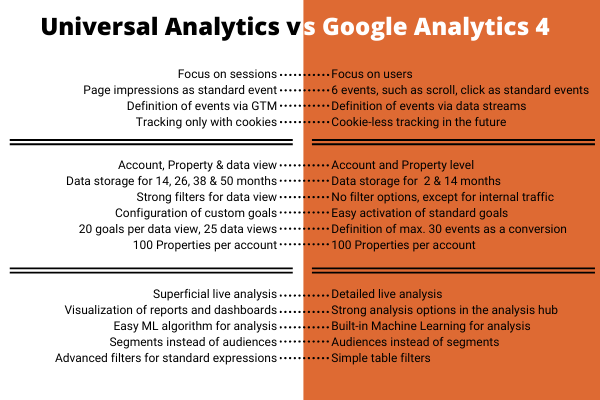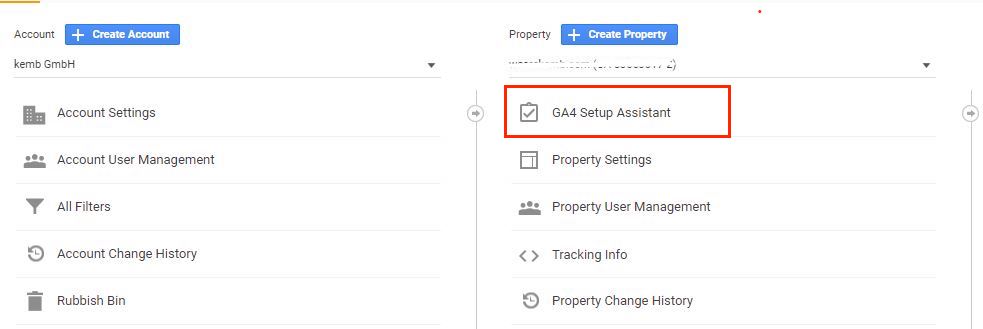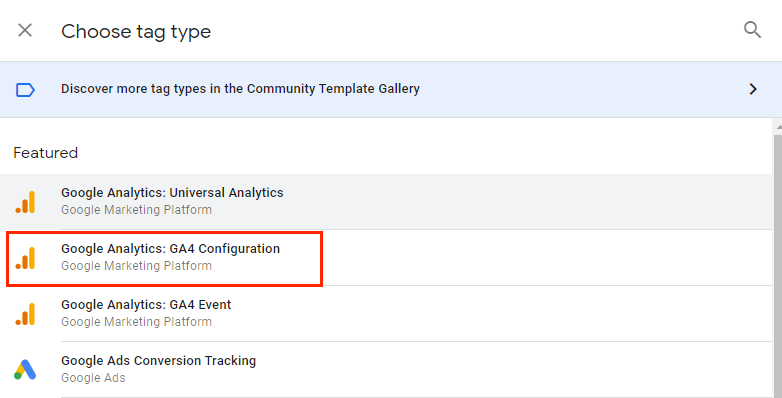
In 2023, Google will stop supporting Universal Analytics and switch all customers to Google Analytics 4. Prepare ahead of time to make your transition as seamless as possible by making GA4 an integral part of your tech stack now. We will discuss how Google Analytics 4 differs from earlier versions and there will also be pointers for maximizing the platform's functionality.
Google Analytics 4: What’s new?
So now comes the question of what new features there are in GA4, and the answer is, in short… a lot. The data collection algorithm and data structure in GA4 are quite different. Now, rather than sessions as in the past, everything is built around users and events. Every user interaction is treated as a separate event in an event-based approach.
This shift is important since, in the past, we relied on a session-based model that categorized user activities over a certain time. Marketing grows significantly from shifting the focus from sessions to events, including improved pathing analytic capabilities and cross-platform analysis.
By switching to an event-based approach, GA4 becomes more adaptable and has improved user behavior prediction.
Google Analytics 4 property events
Normally, the data in your reports comes from activities that occur as people engage with your website or blog. A page view event is triggered whenever a user accesses a page on your site.
The following events may be gathered without the use of any code:
- Automatically collected events: Events that are automatically captured when data collection is set up include first visit, ad clicks, and file downloads.
- Enhanced measurement events: This option automatically gathers enhanced measurement events such as page view, scroll, and video engagement.
- Recommended events: This represents events that you design but that have fixed names and parameters. Common events in this category could be ad impressions, coupon use for purchases, or a search performed by the user on your website directly.
- Custom events: Custom events are ones you designate and give a specific name. If none of the events in the other categories meet your requirements, you can build events that are completely bespoke to your business.

How to make the transition from Universal Analytics to GA4
To update the GA version, you can follow the steps that are listed below:
Step 1:
Easily install GA4 by navigating to the admin part of your reporting view in your GA3 property. Open the admin section and start the process.
Step 2:
You will see that the "Setup Assistant" link for GA4 located under the Property column. Click on it.

Step 3:
You will find the heading "I want to create a new Google Analytics 4 property," click the "Get Started" button.
Step 4:
In this step, you need to click on the Create Property button. New GA4 properties will now be created automatically by Google Analytics. Your current GA property will continue to exist. So you will have access to at least two GA properties. With gtag.js, the GA4 setup assistance operates automatically. You must add the Analytics tag manually if you use a website builder like WordPress, Wix, etc. However, this new GA4 property won't start gathering data automatically. For the data to begin flowing into your new GA4 property, you must configure your GTM (Google Tag Manager).
Step 5:
Now click on the "see your GA4 button. A new tab will open. Click on the Data stream link.
Step 6:
In this step, click on your web data stream. Note: Both "web stream" and "data stream" are used in Google Analytics 4. These two terms refer to the flow of analytics information your website sends to Google Analytics.
Step 7:
Select "Use existing on-page tag" from the Tagging instructions section. Select Google Tag Manager from the drop-down option. Now you will see the instructions for setting up a tag to track your website data in the new GA4 property. Note down the measurement ID.

Step 8:
Go to your GTM account and click the link for New Tags. Give your new tag a name like "GA4 tracking - All pages" and choose Google Analytics: GA4 Configuration as the tag type.

Step 9:
In the Measurement ID text box, type the measurement ID you recorded earlier. Make sure that your trigger fires on all pages. To save your tag, click the Save button.
Step 10:
Click on the Preview button, which is situated in the upper right corner. The Tag Manager Preview mode window will appear in a new browser tab. If it doesn't, it indicates that your browser is blocking the window.
Step 11:
Now enter your website address and click on the Connect button. Your website will appear in a new tab in your browser window as soon as you click the Connect button.
Step 12:
Return to the tab of your browser that displays the Tag Manager Preview mode window, and click the Continue button. Your tag is firing properly if you see the tag "GA4 tracking-All pages" in the Tags Fired column.
Step 13:
Now again, open your GTM account and click the submit tab. Click the Publish button after naming your version. Go back to your website, click on a few pages, and open them. After scrolling up, open your GA4 property again and click the cross button next to the Web stream details.
Finally, check your reports
From the menu on the left, just select the Reports icon.
Your home page report's quick response will be:
- What are the locations of your new users?
- Which of your campaigns performed the best?
- Which screens and pages receive the greatest traffic?

Select Real-time report by clicking over it. Your real-time report should show new data. Remember that Google Analytics 4 reports differ significantly from the Universal Analytics reports. In addition to using the new catalog, several well-known metrics and reports have been totally removed. Basically, you would have to start again with Google Analytics 4 if you were using standard reports like the Top Landing Pages report.
Keep in mind that GA4 property is the default option while establishing a new property from within an existing GA3 property. However, you can still use the GA4 Setup Assistant option in your GA3 property even after you have created your new GA4 property.
The option to "See your GA4 property" should appear when you click the GA4 Setup Assistant link once more, indicating that you have successfully set up the GA4 property and connected it to your previous GA3 property.
What is an App + Web Property?
App + Web was basically Google Analytics 4's beta version. All App + Web properties are now accessible as GA4 properties. This means that you don't need to do anything.
Open the property in your Google Analytics account. The previous Universal Analytics interface will have been replaced with the new GA4 interface.

Next Steps
Google Analytics 4 uses artificial intelligence (AI) to effectively gather user data, provide statistics based on customer life cycles, and help you customize your advertising to your target audience. Combining these elements can increase your chances of conversion and ROI while also building your business.
Using GA4 in combination with MarinOne reporting and conversion tracking tools will give your marketing team complete visibility on all your website impressions, engagement, and actions…with a holistic view of users and events across channels and devices. By automatically connecting and combining siloed marketing data from thousands of sources, you can understand the impact of your marketing at both high and granular levels.
Ready to know your best-performing tactics across the consumer’s journey and optimize every marketing dollar? Speak with one of our expert consultants today to learn how to get started.


.webp)

.webp)